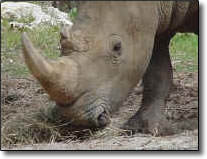Ceratotherium simum simum
a.k.a. Square-lipped Rhinoceros
Description:

The third-largest land mammal following Asian and African elephants. This rhinoceros was not named for its color as many believe. The name is believed to be derived from an Afrikaans word meaning wide; referring to the wide (square) lip. A prominent hump on top of the shoulder distinguishes this large species which can weigh 4000 pounds or more.
Status:
Heavily hunted, this subspecies was nearly eliminated during the settlement of southern Africa in the 18th and 19th centuries. They have been killed for sport, hide, and horn. The horn is carved into ornamental objects or ground into a powder for use as an alleged medicine or aphrodisiac. Cooperative management of this species falls under a Species Survival Plan (SSP). The two rhinos at the Ellen Trout Zoo are young brothers. When it's time to breed these brothers to contribute to the gene pool, one will go to another zoo and a female will be brought here.
This photo of Bwana shows the wide lip characteristic of White Rhinos.

Breeding:
Breeding occurs throughout the year. A male and female may remain together for 5 to 20 days during mating. During this time, chasing and horn clashing may occur. Gestation is about 16 months.
Behavior:
Dominant males spray urine to mark the boundaries of their territory. Its mild temperament can give it the appearance of being tame.
Vocalization:
Has about 10 vocalizations: panting contact call; grunts and snorts associated with courtship; squeals of distress, and deep bellows or growls for threats.
